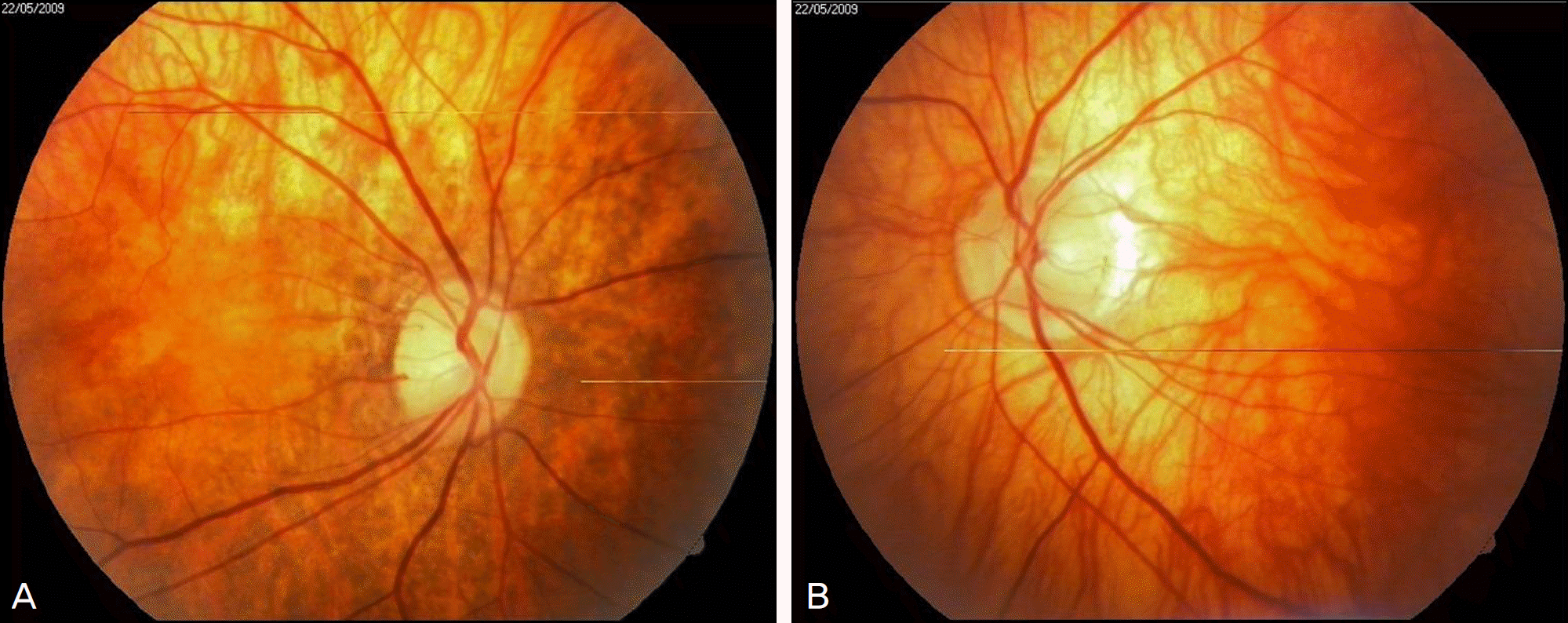Abstract
Case summary
A 53-year-old woman with congenital deafness visited the clinic complaining of photophobia and heterochromic iris in the left eye. Her best-corrected visual acuity was 1.0 in the right eye and 0.7 in the left eye. The patient's left eye showed complete iris hypopigmentation, and the right eye showed segmental iris hypopigmentation. Fundus examination demonstrated generalized decrease in retinal pigment with focal hypopigmented lesions in both eyes. The pupil sizes were 3 mm in the right eye and 5 mm in the left eye. A pure tone audiogram showed profound bilateral sensorineural hearing loss.
References
1. Waardenburg PJ. A new syndrome combining development anomalies of eyelids, eyebrows and nose root with pigmentary defects of the iris and head hair and with congenital deafness. Am J Hum Genet. 1951; 3:195–253.
2. Kim DK, Kim JH. A case of Waardenburg's syndrome. J Korean Ophthalmol Soc. 1981; 22:687–91.
3. Lee OY, Choi YC, Jung NH. A case of type 2 Waardenburg syndrome with open-angle glaucoma. J Korean Ophthalmol Soc. 1999; 40:3532–35.
4. Kee SY, Lee YC, Lee SY. Type 3 Waardenburg syndrome. J Korean Ophthalmol Soc. 2005; 46:726–30.
5. Lim JO, Chung GW, Cho BC. A case of Waardenburg's syndrome. J Korean Ophthalmol Soc. 1986; 27:271–5.
6. Moon YS, Kim JC. Two case of Waardenburg syndrome. J Korean Ophthalmol Soc. 1986; 27:735–40.
7. Song HK, Shin DE. Three case of Waardenburg syndrome in one family. J Korean Ophthalmol Soc. 1987; 28:1137–42.
8. Lee DW, Lee JH, Chang MW. A case of Waardenburg's syndrome. J Korean Ophthalmol Soc. 1997; 38:2247–50.
9. Choi JH, Moon SK, Lee KH, et al. Three cases of Waardenburg syndrome type 2 in a Korean family. Korean J Ophthalmol. 2004; 18:185–9.

11. Tassabehji M, Newton VE, Liu XZ, et al. The mutational spectrum in Waardenburg syndrome. Hum Mol Genet. 1995; 4:2131–7.

12. Mullaney PB, Parsons MA, Weatherhead RG, Karcioglu ZA. Clinical and morphological features of Waardenburg syndrome type II. Eye. 1998; 12:353–7.

13. McCartney AC, Riordan-Eva P, Howes RC, Spalton DJ. Horner's syndrome: an electron microscopic study of a human iris. Br J Ophthalmol. 1992; 76:746–9.

14. Johnston MC, Noden DM, Hazelton RD, et al. Origins of avian ocular and periocular tissues. Exp Eye Res. 1979; 29:27–43.

15. Spritz RA. Piebaldism, Waardenburg syndrome, and related disorders of melanocyte development. Semin Cutan Med Surg. 1997; 16:15–23.

17. Dastur YK, Dudhani A, Chitale A, Dasgupta S. Waardenburg syndrome with anisocoria and exotropia. J Postgrad Med. 1995; 41:111–2.




 PDF
PDF ePub
ePub Citation
Citation Print
Print




 XML Download
XML Download